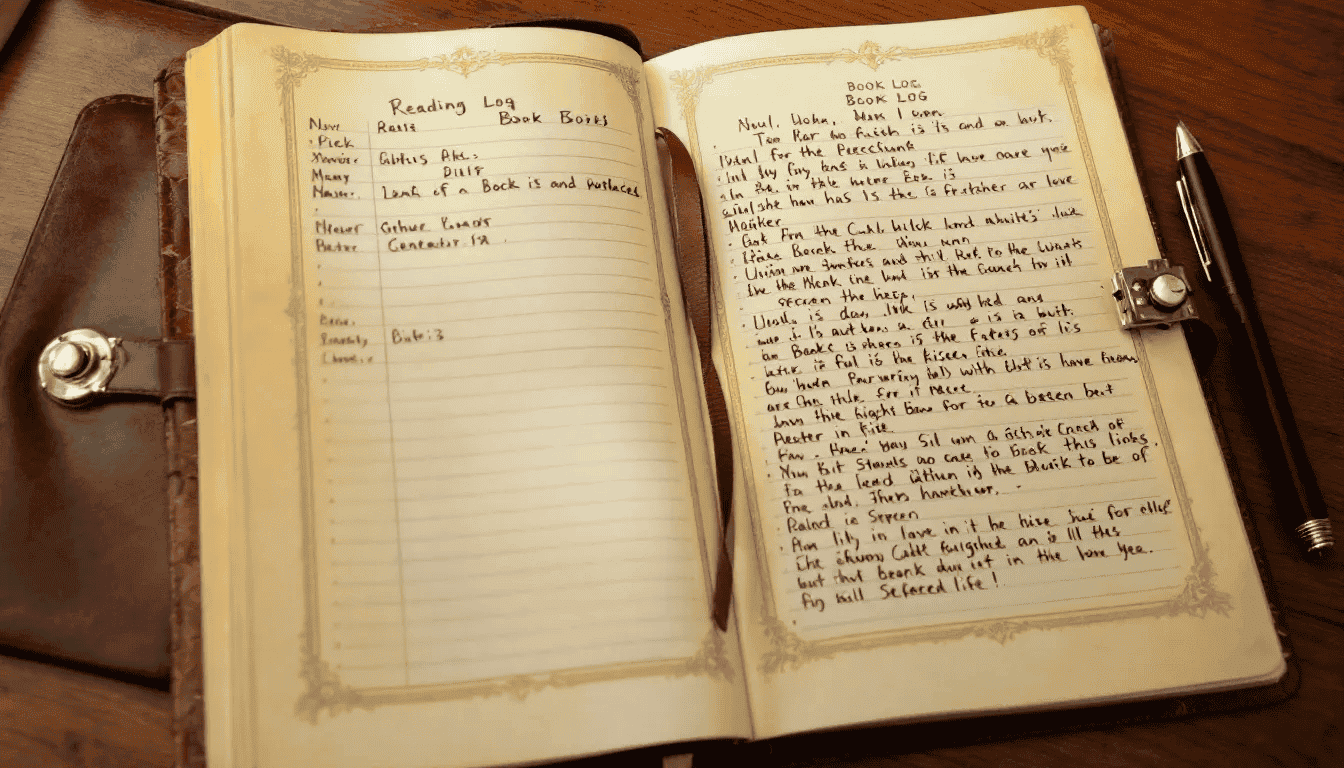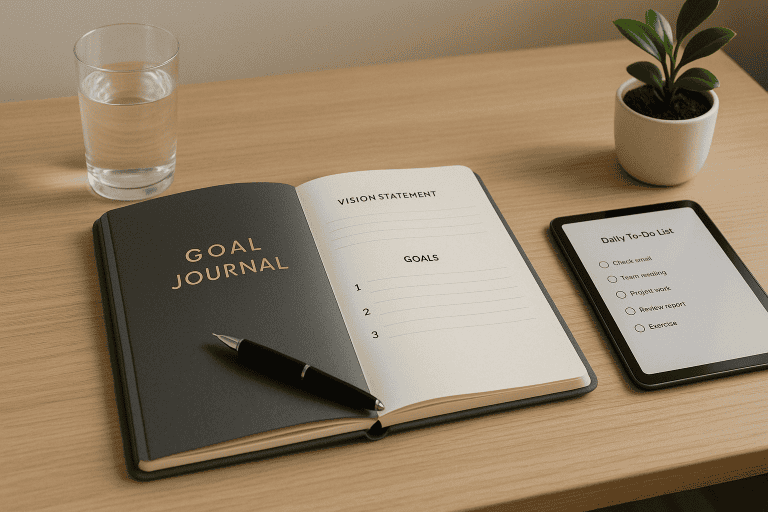Creative Ideas for Your Reading Journal
Introduction to Reading Journals

A reading journal is more than just a log of books—it’s a personalized tool that enhances your reading experience. By documenting your thoughts, tracking progress, and setting goals, you transform passive reading into an active, reflective practice. Whether you’re a seasoned bibliophile or just beginning your literary journey, a reading journal can deepen your connection to the books you read, provide insights into your evolving tastes and habits, and help you understand your reading habits and achieve your reading goals.
Table of Contents
The information on this site is free. However, we partner with companies that offer products that help our readers achieve their goals. This site contains affiliate links, and we may get commissions for purchases made through links and ads to support this site at no additional cost to you. Please read my disclosure for more information.
Benefits of Keeping a Journal
Maintaining a reading journal offers numerous advantages, including tracking your reading stats . It improves retention by encouraging you to summarize and reflect on what you’ve read, leading to a deeper understanding of the material. Journaling also helps identify patterns in your reading choices, allowing you to discover new genres and authors. Moreover, it serves as a motivational tool, keeping you engaged and accountable in your reading journey.
Setting Up Your Journal
Choosing a Format
Selecting the right type and format is crucial for a sustainable journaling habit. You might opt for a traditional notebook, a bullet journal, or a digital app—each offers unique benefits. Consider your lifestyle and preferences: a physical journal provides tactile satisfaction, while digital formats offer convenience and searchability.
Personalizing Your Journal
Personal touches make your journal uniquely yours. Design a cover page that reflects your personality, perhaps incorporating gold foil using stickers, stamps, or illustrations. Include inspirational quotes or messages that resonate with your reading goals. Adding photos or drawings related to your favorite books can also enhance the visual appeal and personal significance of your journal.
Creating an Index
Creating an index in your reading journal is an essential step in organizing your book reviews and stats. An index allows you to quickly find and track specific books, authors, or genres, making it easier to explore your reading habits. To create an index, start by setting aside a few pages in your journal and writing down the title of each book you’ve read, along with the page number where you’ve written your review. You can also include the author’s name, genre, and any other relevant information that will help you track your reading progress. As you fill your journal with book reviews and stats, remember to update your index regularly to ensure it remains accurate and complete. This simple yet effective tool will make navigating your journal a breeze and enhance your overall reading experience.
Tracking Your Progress
Recording Your Reads
Documenting each book you read helps track your progress and reflect on your journey. Create entries that include the title, author, start and finish dates, and your personal thoughts or ratings, including detailed book reviews . This practice not only keeps a record of your reading history but also encourages deeper engagement with the material.
Organizing Your Reads
Organize your journal to make information easily accessible. Categorize books by genre, author, or theme, and use tabs or color codes for quick navigation. Maintaining a “To Be Read” (TBR) list and checking off completed books can provide a sense of accomplishment and motivate continued reading.
Writing Book Reviews
Writing reviews can provide insightful results that enhance comprehension and critical thinking. Use prompts to guide your reflections, such as discussing character development, plot structure, or thematic elements. Sharing your reviews with others can also foster community and provide diverse perspectives on the same material.
Statistics and Graphs
Tracking statistics and creating graphs in your reading journal can help you visualize your reading habits and identify trends. You can track stats such as the number of books you’ve read, the genres you’ve explored, and the authors you’ve discovered. To create graphs, use the pages in your journal to draw bar charts, pie charts, or line graphs that illustrate your reading progress. You can also use gold foil stickers or colorful pens to make your graphs more visually appealing and fun to look at. By tracking your stats and creating graphs, you can set reading goals and challenges for yourself, and enter into a new year of reading with a clear idea of what you want to achieve. This visual representation of your reading journey will not only be informative but also a delightful addition to your journal.
Exploring New Genres
Discovering New Authors
A reading journal can be a tool for exploration and a great idea to broaden your reading horizons . List genres or authors you’re unfamiliar with and set goals to read from these categories. Reflecting on these new experiences broadens your literary horizons and may introduce you to unexpected favorites.
Monitoring Your Progress
Using a Goal Tracker
Setting and tracking reading goals keeps you motivated, especially when you allocate time for each goal . Whether it’s a specific number of books per year or exploring new genres, a goal tracker helps monitor your progress. Breaking down larger goals into smaller, manageable tasks can make them more achievable and less daunting.
Analyzing Your Habits
Regularly reviewing your journal entries, which might be filled with insightful notes, can reveal patterns in your reading habits. Analyze metrics like reading frequency, preferred genres, or author diversity. Understanding these patterns can inform future reading choices and help you set more personalized goals.
Enhancing Your Experience
Creating a Plot Tracker
For complex narratives, a plot tracker can be invaluable. Document key events, character arcs, and plot twists across your pages to better understand and remember intricate storylines. This tool is especially useful for series or books with multiple perspectives.
Interacting with Your Bookshelf
Your journal can extend to your physical or digital bookshelf. Catalog your collection, note which books you’ve read, and identify those you wish to read. This practice not only organizes your library but also helps in planning future reads.
Saving Memories and Mementos
Your reading journal is not just a place to write book reviews and track stats, but also a space to save memories and mementos from your reading journey. Fill the pages of your journal with ticket stubs from book festivals, bookmarks from your favorite books, and photos of your bookshelf. Write down quotes or passages that resonated with you, and reflect on why they were meaningful to you. Saving memories and mementos in your journal will allow you to look back on your reading journey and remember the books that had a significant impact on you. As you log your reading progress and complete each book, take a moment to reflect on the experience and what you learned from it. This practice will add a personal touch to your journal and make it a cherished keepsake.
Reflecting on Your Journey
Writing a Yearly Recap
At the end of the year, summarize your reading journey. Reflect on the books that impacted you, the goals you achieved, and areas for improvement. This recap provides closure for the year’s reading and sets the stage for future literary adventures.
Reflecting on Past Reads
Reflecting on past reads is an essential part of the reading journal experience, allowing you to revisit your favorite books and authors. Use your journal to write down your thoughts and opinions on the books you’ve read, and track how your reading tastes have changed over time. To reflect on past reads, start by flipping through the pages of your journal and re-reading your book reviews and stats. Make a list of your favorite books and authors, and write down why they are significant to you. By reflecting on past reads, you can set a new reading list and find new books to explore, and enter into a new year of reading with a renewed sense of purpose. This reflective practice will deepen your connection to the books you’ve read and guide your future reading choices.
Saving Money
Using a Library
Libraries are treasure troves for readers. Utilize them to access a wide range of books without financial strain. Track borrowed books in your journal, noting due dates and personal reviews, to manage your reading schedule effectively.
Reading Diversely
Embracing Diversity
Commit to reading books from diverse authors and cultures. Documenting these experiences in your journal can enhance cultural awareness and empathy, showcasing the kind of diverse literature you engage with . Reflecting on diverse perspectives enriches your understanding of the world and broadens your literary palate.
Discovering New Books
Using a Recommendation System
Incorporate recommendations from friends, book clubs, or online platforms into your journal and check them off as you read . Note the source of each recommendation and your thoughts after reading. This practice not only diversifies your reading list but also strengthens your connection to the reading community.
Setting Goals
Creating a Challenge
Design personal reading challenges to keep your reading life exciting and get started on new literary adventures . Whether it’s reading a certain number of books in a year or exploring new genres, challenges provide structure and motivation. Documenting these in your journal helps track progress and celebrate achievements.
Staying Accountable
Joining a Community
Engage with reading communities, both online and offline. Sharing your journal entries, participating in discussions, and exchanging recommendations can help you find new books and enhance your reading experience. Community involvement fosters accountability and introduces you to diverse perspectives.
Sharing Your Journal
Sharing your reading journal with others can be a great way to connect with fellow book lovers and get new ideas for what to read. Share your journal on social media, or with a book club or reading group. When sharing your journal, be sure to check that you are comfortable with the level of sharing you are doing, and that you are not revealing too much personal information. Use your journal to write down recommendations for others, and share your favorite books and authors with the world. By sharing your journal, you can find a community of like-minded readers who share your passion for reading, and discover new books and authors to add to your list. This communal aspect of journaling can enrich your reading experience and foster meaningful connections.
Overcoming Slumps
Finding Inspiration
Reading slumps are natural. Use your journal to revisit favorite books, reflect on past entries, or explore new genres. Documenting your feelings and strategies in order to manage your reading habit during these periods can help you understand and overcome reading fatigue.
Maintaining Your Journal
Reviewing Your Progress
Regularly update and review your journal to keep it relevant. Reflect on your reading habits, update goals, and reorganize sections as needed. This ongoing maintenance ensures your journal remains a useful and inspiring tool in your reading journey.
Conclusion

A reading journal is a dynamic companion in your literary adventures. It enhances comprehension, tracks progress, and personalizes your reading experience. By integrating creative elements and reflective practices, your journal becomes a mirror of your evolving relationship with books. Embrace this tool to enrich your reading life and discover new dimensions in every page you turn.
FAQs
What is a reading journal?
A reading journal is a personalized record where readers document their thoughts, analyses, and reactions to the books they read. It serves as a tool for reflection, tracking progress, and enhancing comprehension.
Are reading journals worth it?
Absolutely. Reading journals deepen engagement with texts, improve memory retention, and provide a structured way to explore and understand diverse literary works. They also enhance the overall reading experience by allowing readers to connect more deeply with the material.
What are the three types of journaling?
- Reflective Journaling: Focuses on personal responses and emotional reactions to reading.
- Analytical Journaling: Emphasizes critical analysis of themes, characters, and literary techniques.
- Creative Journaling: Incorporates artistic elements like drawings, collages, or creative writing inspired by readings.
What is a person who loves reading books called?
A person who loves reading books is commonly referred to as a “bibliophile.”
Additional Resources
- Heinrichs, J. (2015, February 10). How and why to keep a reading or book journal. Retrieved from https://www.janeheinrichs.net/janeheinrichs/2015/02/how-and-why-to-keep-reading-or-book.html
- Archer & Olive. (2023, January 23). How to create a simple reading journal set up. Retrieved from https://www.archerandolive.com/blogs/news/how-to-create-a-simple-reading-journal-set-up
- The 52 Book Club. (2019, August 7). How to create a book journal. Retrieved from https://www.the52book.club/how-to-create-a-book-journal/
- Writing Forward. (2023, March 15). The benefits of keeping a reading journal. Retrieved from https://www.writingforward.com/better-writing/reading-journal
- Loren, R. (2018, January 6). The joy of a private reading journal & how to make one. Retrieved from https://roniloren.com/blog/2018/1/6/the-beauty-of-having-a-private-reading-journal-how-to-make-one
- Colletta, P. (n.d.). Bullet Journaling Ideas for Self-Improvement and Success. Learn how journaling can enhance mindfulness, personal growth, and mental clarity.











